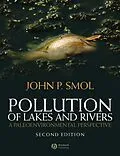Now in its second edition, Pollution of Lakes and Rivers provides essential insights into present-day water quality problems from an international perspective. * Explains simply and effectively how lake sediments can be used to reconstruct pollution history * Includes over 200 additional references and a new chapter on recent climatic change and its effects on water quality and quantity * Tackles present-day water quality problems from an international perspective * Previously published by Hodder Arnold PowerPoint slides of the artwork from the book are available from: href="http://post.queensu.ca/~pearl/textbook.htm">http://post.queensu.ca/~pearl/textbook.htm Reviews: "This is a very well-written and wide-ranging volume that is both instructive and topical. It is likely to prove useful as an introduction to the general area, a reference source and for teaching purposes." (The Holocene, November 2008) "If you thought that paleolimnology was just mud, pollen, and diatoms then you will likely be both struck by the complexity of this field of research and grateful that John Smol, FRSC, has described it so clearly and broadly. Simply put, the second edition is an excellent book." ( Journal of Phycology, 2008) "This is a useful text. It provides a good level of detail so that the beginner in this area can appreciate what palaeolimnology can (and cannot) achieve. It goes beyond the simple introduction to provide a detailed understanding of how techniques can be applied ... This is a different take on the usual pollution text and would be of great use to those wishing to understand more from sedimentary records." Taken from the British Ecological Society's Teaching Ecology website "John Smol has extensive experience in this field of paleoenvironmental research which he combines well with his excellent written communication skills to produce a text that is easy to read but also thought provoking." (Quaternary Science Reviews, 2009) "The breadth of coverage in this text is impressive." (Lake and Reservoir Management, 2009) "If I could speak with fluidity and clarity in my lectures as consistently as John Smol writes my students would be very grateful." (Journal of Paleolimnology, 2009)
Autorentext
John P. Smol FRSC is a Professor in the Department of Biology at Queen's University, Kingston, Ontario, Canada, with a cross-appointment at the School of Environmental Studies. He holds the Canada Research Chair in Environmental Change, and is the Editor-in-Chief for the journal Environmental Reviews and is the founding editor of the Journal of Paleolimnology, which he edited from 1987 to 2007
Zusammenfassung
Now in its second edition, Pollution of Lakes and Rivers provides essential insights into present-day water quality problems from an international perspective.
- Explains simply and effectively how lake sediments can be used to reconstruct pollution history
- Includes over 200 additional references and a new chapter on recent climatic change and its effects on water quality and quantity
- Tackles present-day water quality problems from an international perspective
- Previously published by Hodder Arnold
PowerPoint slides of the artwork from the book are available from:
http://post.queensu.ca/~pearl/textbook.htm
Reviews:
"This is a very well-written and wide-ranging volume that is both instructive and topical. It is likely to prove useful as an introduction to the general area, a reference source and for teaching purposes." (The Holocene, November 2008)
"If you thought that paleolimnology was just mud, pollen, and diatoms then you will likely be both struck by the complexity of this field of research and grateful that John Smol, FRSC, has described it so clearly and broadly. Simply put, the second edition is an excellent book." ( Journal of Phycology, 2008)
This is a useful text. It provides a good level of detail so that the beginner in this area can appreciate what palaeolimnology can (and cannot) achieve. It goes beyond the simple introduction to provide a detailed understanding of how techniques can be applied ... This is a different take on the usual pollution text and would be of great use to those wishing to understand more from sedimentary records. Taken from the British Ecological Society's Teaching Ecology website
"John Smol has extensive experience in this field of paleoenvironmental research which he combines well with his excellent written communication skills to produce a text that is easy to read but also thought provoking." (Quaternary Science Reviews, 2009)
The breadth of coverage in this text is impressive. (Lake and Reservoir Management, 2009)
If I could speak with fluidity and clarity in my lectures as consistently as John Smol writes my students would be very grateful. (Journal of Paleolimnology, 2009)
Inhalt
Preface to the second edition.
About the author.
1 There is no substitute for water.
2 How long is long?.
3 Sediments: an ecosystem's memory.
4 Retrieving the sedimentary archive and establishing the
geochronological clock: collecting and dating sediment cores.
5 Reading the records stored in sediments: the present is a key
to the past.
6 The paleolimnologist's Rosetta Stone: calibrating
indicators to environmental variables using surface-sediment
training sets.
7 Acidification: finding the "smoking gun".
8 Metals, technological development, and the environment.
9 Persistent organic pollutants: industrially synthesized
chemicals "hopping" across the planet.
10 Mercury - "the metal that slipped
away".
11 Eutrophication: the environmental consequences of
over-fertilization.
12 Erosion: tracking the accelerated movement of material from
land to water.
13 Species invasions, biomanipulations, and extirpations.
14 Greenhouse gas emissions and a changing atmosphere: tracking
the effects of climatic change on water resources.
15 Ozone depletion, acid rain, and climatic warming: the
problems of multiple stressors.
16 New problems, new challenges.
17 Paleolimnology: a window on the past, a key to our
future.
Glossary.
References.
Index
